Ekuador |
|
|
|
| Übersicht – Contents: | |
Diese Seite ist Teil des Projektes
Ekuador |
|
|
|
| Übersicht – Contents: | |
Flaggen – Flags: |
|
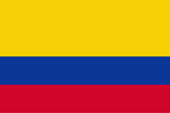 |
National- und Handelsflagge – national and merchant flag, Seitenverhältnis – ratio = 2:3, Quelle/Source nach/by: Corel Draw 4, Flaggen und Wappen |
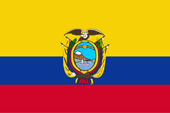 |
Staats- und Marineflagge – state flag and naval flag, Seitenverhältnis – ratio = 2:3, Quelle/Source nach/by: Corel Draw 4, Flaggen und Wappen |
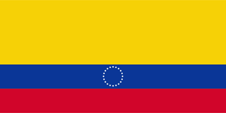 |
Dienstflagge der Munizipalbehörden – official flag of the munizipal authorities, Seitenverhältnis – ratio = 1:2, Quelle/Source nach/by: Flags of the World |
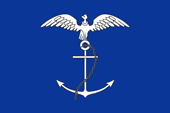 |
Gösch – naval jack, Seitenverhältnis – ratio = 2:3, Quelle/Source nach/by: Flags of the World |
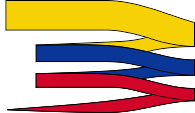 |
Kommandowimpel – Masthead pennant, Quelle/Source nach/by: Flags of the World |
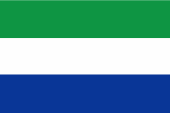 |
Flagge der Galapagos-Inseln |
historische Flaggen – historical Flags: |
|
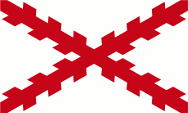 |
16. Jhd./cent. – 1785, zum spanischen Machtbereich – to the Spanish sphere of influence, Quelle/Source nach/by: Wikipedia (EN) |
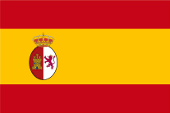 |
1785–1822, zum spanischen Machtbereich – to the Spanish sphere of influence, Quelle/Source nach/by: Wikipedia (EN) |
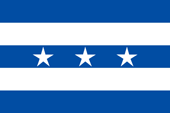 |
1820–1822, Nationalflagge – national flag, Quelle/Source nach/by: Wikipedia (DE) |
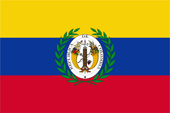 |
1822–1830, Nationalflagge Großkolumbiens – flag of Greater Colombia, Quelle/Source, nach/by: Milenioscuro [CC BY-SA 3.0], via Wikimedia Commons |
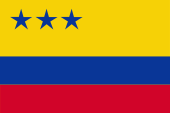 |
1822–1830, |
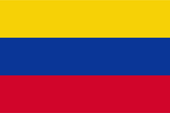 |
1830–1845, Nationalflagge – national flag (?), Quelle/Source nach/by: Flags of the World |
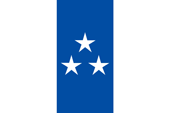 |
März/March 1845, Nationalflagge – national flag, Quelle/Source nach/by: Wikipedia (DE) |
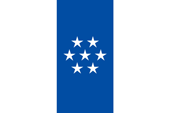 |
November 1845, Nationalflagge – national flag, Quelle/Source nach/by: Wikipedia (DE) |
 |
1860–1900, Nationalflagge – national flag, Seitenverhältnis – ratio = 2:3, Quelle/Source: Flags of the World |
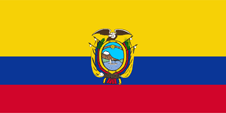 |
1900–2009, Staats- und Marineflagge – state flag and naval flag, Seitenverhältnis – ratio = 1:2, Quelle/Source nach/by: Corel Draw 4, Flaggen und Wappen |
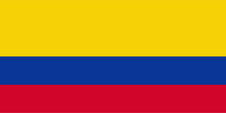 |
1900–2009, National- und Handelsflagge – national and merchant flag, Seitenverhältnis – ratio = 1:2, Quelle/Source nach/by: Corel Draw 4, Flaggen und Wappen |
Bedeutung/Ursprung der Flagge – Meaning/Origin of the Flag: |
|
| Die erste Flagge des unabhängigen Staates war während eines gegen die Spanier gerichteten Aufstands im Jahre 1820 gehisst worden, als in der Provinz Guayaquil, als von den Spaniern befreites Gebiet, eine Flagge mit abwechselnd fünf Streifen in Blau und Weiß und drei weißen Sternen in der Mitte gehisst wurde. Die Unabhängigkeit von Spanien folgte 1822 als Staat Großkolumbien, von dem das heutige Ekuador ein Teil gewesen ist. Die Flagge Großkolumbiens wird in dieser Zeit als horizontal gelb-blau-rot gestreift beschrieben, allerdings einmal mit drei blauen Sternen in der Oberecke, einmal mit einem Wappen in der Mitte. Großkolumbien zerfiel 1830 in die Länder Venezuela, Kolumbien und Ekuador. Welche Flagge jetzt in Ekuador wehte ist nicht wirklich bekannt. Wahrscheinlich war die Flagge horizontal gelb-blau-rot gestreift, ohne das Wappen Großkolumbiens, bzw. ohne die drei Sterne. Einige Quellen beschreiben auch ein eigenes Wappen in der Mitte der Flagge. Im Jahre 1845 kam es zu einer liberalen Revolution, in deren Folge eine neue Flagge angenommen wurde. Sie war senkrecht weiß-blau-weiß gestreift und zeigt im mittleren blauen Streifen zunächst drei Sterne, später sieben, oder gar neun. Bis 1860 bleibt die Lage unübersichtlich (nicht nur was die Flagge angeht), vier Regierungen bekämpften sich gleichzeitig, das Land versinkt in Chaos. Im Jahre 1860 konnte sich der Konservative Gabriel García Moreno durchsetzen und das Chaos im Land beenden. Er führte die gelb-blau-rote Flagge wieder ein, so wie sie bis heute verwendet wird. Am 07.11.1900 wurden die Seitenverhältnisse der Flagge auf 1:2 festgelegt, im Jahre 2009 auf 2:3 abgeändert. Am 13. März 2003 verabschiedete der Nationalkongresses die Resolution 24-047, welche die Gestaltung des Wappens neu regelt. Sie trat am 21. März 2003 in Kraft. Die Farben werden dabei folgendermaßen festgelegt: Gelb = pt 116, Blau = pt 287 , Rot = pt 186. Die Flagge zeigt drei waagerechte Streifen in Gelb, Blau und Rot im Verhältnis 2:1:1. Der breitere gelbe Streifen war eigentlich zur Aufnahme von Wappen oder ähnlichem vorgesehen, jedoch machte Ekuador davon keinen Gebrauch und setzte das Wappen in die Mitte. |
The first flag of the
independent state was hoisted during an uprising against the Spaniards in
1820, when in the province of Guayaquil, as a from the Spaniards liberated
area, a flag with alternating five stripes in blue and white and three white
stars in the middle was hoisted. The independence from Spain followed in 1822 as the State of Greater Colombia, of which today's Ecuador was a part. The flag of Greater Colombia is described as horizontal yellow-blue-red striped at this time, but once with three blue stars in the upper corner and once with a coat of arms in the middle. Greater Colombia split up in 1830 into Venezuela, Colombia and Ecuador. It is not really known which flag was flying in Ecuador now. The flag was probably striped horizontally in yellow, blue and red, without the coat of arms of Greater Colombia or without the three stars. Some sources also describe a separate coat of arms in the center of the flag. In 1845 there was a liberal revolution, as a result of which a new flag was adopted. It was white-blue-white striped vertically and initially showed three stars in the middle blue stripe, later seven, or even nine. Until 1860 the situation remained confusing (and not only in terms of the flag), four governments fought each other at the same time, the country sank into chaos. In 1860 the conservative Gabriel García Moreno was able to assert himself and end the chaos in the country. He reintroduced the yellow-blue-red flag as it is used to this day. On 7th of November in 1900 the aspect ratio of the flag was set to 1:2, in 2009 it was changed to 2:3. On 13th of March in 2003, the National Congress passed the resolution 24-047, which regulates the design of the coat of arms. It came into force on 21st of March in 2003. The colors there are determined as follows: yellow = pt 116, blue = pt 287, red = pt 186. The flag shows three horizontal stripes in yellow, blue and red in the ratio 2:1:1. The broader yellow stripe was actually arranged to give place for coats of arms or such things, however Ecuador doesn't use this, and placed the coat of arms in the middle. |
| Die
Farben Gelb, Blau und Rot sollen die Trennung des Landes (Landesfarbe: Gelb)
von der Kolonialmacht Spanien (Landesfarbe: Rot) durch das Meer (Blau)
symbolisieren. Gelb steht auch für den Reichtum des Landes, für den Sonnenschein und die Kornfelder. Blau steht für den Himmel, den Ozean und die Flüsse, und Rot steht für das für die Unabhängigkeit vergossene Blut. |
The colours yellow, blue and red should symbolize the separation of the country (colour of the country: yellow) from the colonial might of Spain (colour of the country: red) by the ocean (blue). Yellow stands as well for the wealth of the country, for the sunshine and the grain fields. Blue stands for the heaven, the ocean and the rivers, and red symbolizes the for the independence given blood. |
| Die Farbkombination geht zurück auf den venezolanischen Freiheitskämpfer Francicso de Miranda (1750–1816). Er verwendete als erster eine Flagge mit diesen Farben. Ab diesem Zeitpunkt wurde diese Flagge in verschiedenen, leicht abgewandelten Formen verwendet. Erstmals war sie bereits im Jahre 1807 bei einem Feldzug der Befreiungsarmee gegen Ortschaften im Norden Venezuelas in Gebrauch. | This
combination of colours goes back to the Venezuelan freedom fighter Francicso
de Miranda (1750–1816). He used first a flag with this colours. From this
point of time the flag was used in various some changed designs. For the first time it was in use already in the year 1807 during a campaign of the liberation army against places in the north of Venezuela. |
| Miranda wählte als Farben Gelb, Blau und Rot. Häufig wird unterstellt, dass Miranda "Hellblau" gewählt hätte, was auch auf einigen Flaggendarstellungen aus dieser Region und Zeit zu finden ist. Das ist problematisch. Flaggen als historische Fundstücke werden oft mit dem modernen Auge betrachtet, und schnell wird eine bestimmte Farbbezeichnung verwendet. Dabei wird völlig ignoriert, dass das Hellblau auf Auswaschen und Verbleichen zurückzuführen ist, eine bei Indigo (einen anderen Farbstoff gab es damals noch nicht) bis heute bekannte und auch entsprechend ausgenutzte Eigenschaft. | Miranda chose yellow, blue and red as colours. It is often assumed that Miranda would have chosen "light blue", which can also be found on some flag representations from this region and time.
This is problematic. Flags as historical finds are often viewed with the modern eye, and a specific color designation is quickly used. That ignores completely the fact that the light blue is due to washout and bleaching, a property known to Indigo (no other dye was known at that time) until today and also suitably exploited. |
| Venezuela und Kolumbien verwenden ähnliche Flaggen, ein Hinweis auf die einstige historische Vereinigung der Länder Ekuador, Venezuela und Kolumbien innerhalb Großkolumbiens. | Venezuela and Colombia use similar flags, a hint at the once historical unification of the countries Ecuador, Venezuela and Colombia within Greater Colombia. |
| Quelle/Source: Die Welt der Flaggen, eluniverso.com, Metodología para la normalización gráfica, Wikipedia (DE) | |
Wappen – Coat of Arms: |
|
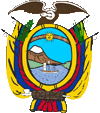 |
seit 1900, Wappen von Ekuador – coat of arms of Ecuador, Quelle/Source nach/by: Flaggen und Wappen, Corel Draw 4 |
Bedeutung/Ursprung des Wappens – Meaning/Origin of the Coat of Arms: |
|
| Das Staatswappen zeigt auf einem ovalen den höchsten Berg des Landes, den Chimborazo, und im Vordergrund ein Schiff als Symbol für den Handel. Oben im Schild die Sonne der Freiheit und die Tierkreiszeichen jener Monate des Jahres 1845, in denen im Lande die Revolution stattfand. Oberhalb des Schildes sitzt ein Kondor. Er ist das Sinnbild der Unabhängigkeit. Unterhalb des Schildes ein Liktorenbündel. Es verkörpert die republikanische Staatsordnung. Am 13. März 2003 verabschiedete der Nationalkongresses die Resolution 24-047, welche die Gestaltung des Wappens neu regelt. Sie trat am 21. März 2003 in Kraft. | The coat
of arms showes on an oval shield the highest mountain of the land, the
Chimborazo, and in the foreground a ship as symbol for the trade. Up in the shield the sun of liberty and the zodiacal signs of those month of the year 1845, in which the revolution tookes place. Above the shield a condor. He is the symbol of the independence. Underneath the shield a fagot. It embodys the republican state's order. On 13th of March in 2003, the National Congress passed the resolution 24-047, which regulates the design of the coat of arms. It came into force on 21st of March in 2003. |
Flugzeugkokarde – aircraft roundel: |
|
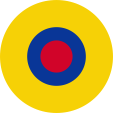 |
Flugzeugkokarde – aircraft roundel Quelle/Source: nach/by Wikipedia (EN) |
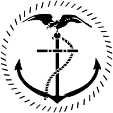 |
Flugzeugkokarde für Marineflieger – aircraft roundel for Naval Aviation Quelle/Source: nach/by Wikipedia (EN), Ecuadorian_Air_Force_roundel.svg: sladyNaval_Jack_of_Ecuador.svg: Denelson83, Huhsunquderivative work: NikNaks talk - gallery - wikipedia, CC BY-SA 3.0, via Wikimedia Commons |
| Landkarten – Maps: |
Lage – Position: |
Landkarte des Landes – Map of the Country: |
Zahlen und Fakten – Numbers and Facts: |
|
|
|
|
|
|
|
|
|
|
|
|
|
|
|
|
|
|
|
|
|
|
|
|
Geschichte: |
|
1465–1534
· Provinz des Inkareichs 1533–1534 · spanische Eroberung 1822 · Unabhängigkeit von Spanien 1822–1830 · zu Großkolumbien 1830 · staatliche Unabhängigkeit 1875–1930 · Krisen, Unruhen, Bürgerkriege 1941 · Besetzung der Provinz El Oro durch Peru 1941–1942 · Krieg gegen Peru 1942 · Abtretung der Provinz El Oro an Peru 1948–1960 · wirtschaftlicher Aufschwungs 1972 · Beginn der Erdölförderung 1972–1978 · Militärdiktaturen 1978 · Verfassung, Rückkehr zur Demokratie 1983 · beginnender wirtschaftlicher Niedergang 1995 · militärische Konflikte mit Peru, Ekuador muss erneut Gebiete abtreten 26.10.1998 · Grenz- und Friedensvertrag mit Peru |
History: |
|
1465–1534
· province of the Inca Empire 1533–1534 · Spanish capture 1822 · independence from Spain 1822–1830 · to Great Colombia 1830 · state independence 1875–1930 · crisis, revolts, civil wars 1941 · occupation of the El Oro province by Peru 1941–1942 · war against Peru 1942 · ceding of the Province of El Oro to Peru 1948–1960 · economic boom 1972 · start of the mineral oil mining 1972–1978 · military dictatorships 1978 · constitution, return to the democracy 1983 · beginning economic decline 1995 · military quarrels with Peru, Ecuador has to cede territories one more 26th of October in 1998 · border and peace treaty with Peru |
| Quelle/Source: Atlas zur Geschichte, Weltgeschichte, Wikipedia (D) |
Ursprung des Landesnamens – Origin of the Country's Name: |
|
| Wie der Name des Landes schon vermuten lässt, geht dieser auf die Lage des Landes unter dem Äquator zurück. Der Name geht auf eine französisch-spanischen Expedition des 18. Jahrhunderts zurück, welche die Lage des Äquators über das Land vermesen hatte. Allerdings wurde die Gegend in der spanischen Zeit unter dem Namen "Real Audiencia de Quito" (Gerichtsbezirk Quito) zusammengefasst, was im Jahre 1810 zunächst zur Proklamation der 'Republik Quito' führte, die jedoch nur zwei Jahre bestand. | As the
name of the country suggests, this goes back to the position of the country
under the equator. The name has its roots in a Franco-Spanish expedition of
the 18th century, century, which had surveyed the position of the equator
across the country. However, the area has been summarized in the Spanish time under the name "Real Audiencia de Quito" (judicial district of Quito), which initially finished in 1810 to the proclamation of the 'Republic of Quito', and it consisted of only two years. |
| Quelle/Source: Handbuch der geographischen Namen, Wikipedia (D) | |